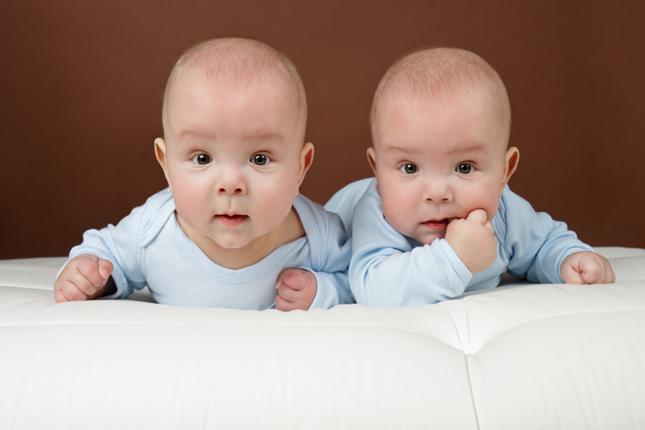Twin Talks
Tips for Telling Your Identical Twins Apart
[00:00:00]
Please be advised, this transcription was performed from a company independent of New Mommy Media, LLC. As such, translation was required which may alter the accuracy of the transcription.
[Theme Music]
CHRISTINE STEWART-FITZGERALD: It’s a looming nightmare for every parent of identical twin babies – getting them mixed up. What happens if you don’t know who’s who? What can you do to make sure that you or your family members never get to confuse? Joining us today is our panel of twin parents who are here to talk about: “Strategies for telling your identical apart.” This is Twin Talks.
[Theme Music/Intro]
CHRISTINE STEWART-FITZGERALD: If you’re pregnant with twins or you’re an experienced twin parent, odds are: “You have heard it all before.” Now, it’s time to hear from the experts. This is Twin Talks, parenting times two. Welcome to Twin Talks broadcasting from the Birth Education Centre of San Diego. Twin Talks is your weekly online on-the-go support group for expecting and new parents to twins. I’m your host Christine Stewart-Fitzgerald. Have you heard about the Twin Talks Club? Our members get bonus content after each new show plus special giveaways and discounts. Subscribe to our monthly Twin Talks Newsletter and learn about the latest episodes available. Another way for you to stay connected is by downloading our free Twin Talks app. It’s available for most smartphones. So before we get started, let’s go around here in our studio and on the phone; and introduce our panellist. So on the phone; we have Mandy with us today. Maybe you can tell us a little bit about your family?
MANDY WILSON: Hi. I’m Mandy. We are at St. Pete, Florida. My husband and I were married for about five years now and we have two year old twin girls – Zoey and Riley.
CHRISTINE STEWART-FITZGERALD: All right. I love those names. Here on our studio, we have Sunny.
SUNNY GAULT: All right. Hi everybody. I’m Sunny. I’m the owner of New Mommy Media which produces: “Twin Talks, Parent Savers, Preggie Pals and The Boob Group.” Our family, we have four children. My oldest is about to turn four. Then my middle guy is two and then I have identical twin girls – Ainsley and Addison who are eight months old.
SHELLY STEELY: I’m Shelly. I’m the producer here at Twin Talks. I have identical twin boys – Grayson and Sawyer who just turned two. I’m expecting a singleton in August. I wanted to let you guys know at home about our Virtual Panellist Program. So, if you can’t make it into the studio or by phone, you can still participate in the conversation by using the hash tag #TwinTalksVP on our Facebook or Twitter page.
CHRISTINE STEWART-FITZGERALD: All right and I’m your host Christine Stewart-Fitzgerald. My girls are almost five. They are very much identical. Everyone seems to get them confused. I can say: “My parents got them confused for like their first year of life.” My dad still does. Then, I do have a singleton girl who is almost two and even though she looks like her sister, she could not be any more different personality-wise. So, there’s no getting her mixed up.
[Theme Music]
SUNNY GAULT: All right, we have a special segment today called: “We’re expecting what?” This is where we share some of your funny stories of when you found out you’re pregnant with twins and funny things that happen maybe shortly thereafter. This comes from Rebecca.
Rebecca writes:
At eight weeks, I found out that I was pregnant with twins. I was so excited. I brought the ultrasound pictures home to show my husband and kids. I told my kids that: “The twins are very tiny and they looked like two little eggs.” My daughter looked at me and said: “Mommy, you are a chicken now.” -Rebecca
All right, well thank you so much Rebecca for sending this in. If you guys have a funny story that you want to share with about when you first found out you are pregnant with twins, please send it to us. You can send it to us through our website or call our voice mail at 619-866-47-75
[Theme Music]
CHRISTINE STEWART-FITZGERALD: Well, today’s topic is: “Strategies for telling your identical apart.” Now, today we’re chatting with our twin parent panellists about: “How to tell your twins apart and keep it that way.” Well, thanks for joining us. Okay, when your twins were first born, could you actually tell them apart?
SUNNY GAULT: No. I didn’t really try though. I think I just got it in my head that I wasn’t going to be able to do it. I think I was: “I had a C Section so I was recovering and I was more focused on my milk coming in.” That was the only thing I could think of – milk, milk and milk; like willing my body to make milk. So, I knew that they were very similar in weight. When I kind of looked at them, they looked the same. I just thought: “They’re going to change so much in the first year of life.” I just really didn’t try in the beginning.
CHRISTINE STEWART-FITZGERALD: So, you knew at the hospital is going to have – put their little caps on and wrist bands. You’re just like: “Hey. That works for now.”
SUNNY GAULT: Yes, I was more upset about – I had my perinatologist told me at one point that: “Sometimes they do mix it up like the whole time.” The whole time that you’re pregnant, you’re like: “This is Baby A and this is Baby B when you go to your appointments.” I was told that: “Sometimes, they can mix it up when they delivered. So, you’re Baby A is actually Baby B or whatever.” I was more upset about that which was ridiculous, right?
CHRISTINE STEWART-FITZGERALD: Right.
SUNNY GAULT: It is just in your head. You feel like: “You’re bonding with Baby A and that comes out.” So, I was more concerned about that. Once they were out and they put the wrist bands on, I’m like right after they were born – I was like: “Okay, they have labelled them. I’ll figure it out later.”
CHRISTINE STEWART-FITZGERALD: Yes.
SUNNY GAULT: I wasn’t concerned about it.
CHRISTINE STEWART-FITZGERALD: How about Mandy? How about it for you?
MANDY WILSON: I actually have the opposite thing of my girls were extremely easy to tell apart when they were first born because Riley who was my Twin B was almost – she was growth restricted. So, she was almost two pounds smaller than Zoey even when they were born. So Zoey was obviously very, very much bigger than Riley. It actually has taken them almost – it was finely they’re 18 months appointment that they were both equal in weight and height finally.
CHRISTINE STEWART-FITZGERALD: Wow.
MANDY WILSON: So, they’ve always been easy to tell apart just by their sheer size difference.
CHRISTINE STEWART-FITZGERALD: Okay, interesting. So, you didn’t definitely didn’t have to worry about it. Okay, here’s the smaller one. Here’s the bigger one. We got that figured out.
MANDY WILSON: Yes. Now however, they look virtually indistinguishable. They’re very hard to tell apart now.
CHRISTINE STEWART-FITZGERALD: What? So, do you find yourself having more trouble now?
MANDY WILSON: I find myself having to – I have to be sure that I see them face on most of the time – to see their facial expressions. They have much different facial expressions and mannerisms now. That they’re older that once I see them, they’re obviously – Zoey or Riley; but just to see them from the back or out a quick glance, it’s very hard to tell at this point.
CHRISTINE STEWART-FITZGERALD: Right and I hear you.
SHELLY STEELY: We have a totally different experience than both of you. Because Sunny knew: “She was going to have identical twins and not tell them apart.” Then Mandy, I remember yours were so different. I thought I was having fraternal twins because I have di-amniotic, di-chorionic so the odds that being identical I thought were small. Then, they came out the exact same size. I mean they were within a couple of ounces of each other. So, here I am expecting fraternal twin boys and then somebody shows up with two infants exactly the same size. Then, people didn’t believe me. They were like: “What are the odds that they’re identical anyway?” I was like: “Are you looking at the same children?” I’m looking at I mean these are remarkably similar. So, I’ve always been really good at telling twins apart in general. So, if you could give me both of my twins at the same exact time face on, I can always tell them apart. I mean I’ve never have to question. But, in the middle of the night from across the room, half asleep with my husband etcetera – those were challenges. So, we left the hospital bracelets on as long as we could and then we painted a toe nail.
CHRISTINE STEWART-FITZGERALD: I mean obviously my experience is similar to Shelly’s in that. I remember at my first check up, my OB told me that: “Yes. It looks like they’re fraternal because there is a really good separation in the sacs.” So I’d like: “Okay, sounds good.” So, the whole time I’m expecting fraternal girls. They’re born and I thought: “They looked alike and they measured with in ounces of each other.” I said: “Well, yes they look alike.” So, I joined local twins club and some of my friends, they said: “No. They’re not fraternal.” I said: “Really?” I mean come on. They can look like. They’re siblings, right? So, then I was convince they were fraternal until we get the DNA tests. I was I guess the last to know.
But, it was interesting because I find that: “The fact that I really truly thought of them as being fraternal, I saw the differences.” So yes, I’ve noticed that one of them has a whiter face and more rounder eyes and fuller lips than the other one. I just key-in on that from the very beginning because I thought: “Well, they’re just fraternal and what not.” So, the one you know [inaudible] is that: “One of them had a little birth mark – the little strawberry mark on her belly.” So, that was always sort of our go-to thing if we were really confused. So, yes I guess I wasn’t really worried about that either as much.
SUNNY GAULT: Yes.
CHRISTINE STEWART-FITZGERALD: I guess for Sunny, did you look for the facial features and birth marks? Shelly too, what was it when you were looking at them that you were keying into for noticing these kinds of subtle differences?
SUNNY GAULT: Well, I couldn’t really tell them apart. I was looking for anything. It’s really I just couldn’t tell them apart. I pretty much had a panic attack anytime I thought about taking off those hospital ID bracelets. But at the same time, they were preemies. They were born at 35 weeks. But, they were about 5 ½ pounds both of them. So, they weren’t super small. But anyways, I didn’t want the harsh little bracelets on and for a really -- they just you know I think it would hurt. Yes. So, I can’t remember how they were. Maybe after a couple of weeks or something once when were at home. My mom and I had this grandiose idea. It worked for a while. Of taking off the hospital bracelets but then assigning each girl like of colour and we did ribbons on their wrist because I thought: “Well, that would be softer and it’s pretty.” We tied little bow or whatever. So, that kind of worked for us for a while until they got a little bit older and then the ribbons kind of get a little gross. We have to change up the ribbons. I’m like: “Maybe we should put like, maybe they should be elastic or maybe they should be this.” We’re trying to do this whole ribbon thing. So, in the mean time, we’re just trying to figure them: “Well, I would need the ribbons if I could just figure out what my kids look like.” But, I mean I felt inferior because of it because I was like I was asking other twin moms: “When did you, when were you able to tell your twins apart because I can’t figure this out.” My mom could tell my twins apart before I could.
CHRISTINE STEWART-FITZGERALD: Really?
SUNNY GAULT: Yes.
CHRISTINE STEWART-FITZGERALD: My gosh. So, you felt a little bit guilty almost?
SUNNY GAULT: I felt very guilty. I mean I didn’t know I was pregnant with twins. I have a doctor tell me that at 11 weeks. I feel like: “I should have some mommy intuition about that.” Then, my kids come out, I can’t tell them apart. My husband can’t tell them apart. I had a moment where the bracelets – not the hospital bracelets but the ribbons I had on them fell off. Then, I have two babies and for two days, I didn’t know who was who.
CHRISTINE STEWART-FITZGERALD: My gosh.
SUNNY GAULT: The only reason I figured it out who-was-who is because: “We had just an appointment where they were weighed.” So, I knew one had always been just a couple of ounces different than the other weighed more even in utero. So, the only reason I could tell is: “At the next appointment which was only a few days later, she still weighed more.” Now, I can tell them apart. It’s okay. Everything’s fine now but like I don’t know. I just couldn’t. I was looking for any feature and nothing.
CHRISTINE STEWART-FITZGERALD: You know I wonder: “Is that a common thread?” As a mom, people probably just expect us to know if the mommy – the instinct and if we don’t, I mean a lot of moms feeling like: “My gosh. This is some sort of inadequacy.” I mean I’m supposed to know this. I think probably we do get too much pressure from other people.
SUNNY GAULT: Yes. Well, I really didn’t know. I really thought that something was wrong. I thought I should have that mommy intuition and I didn’t.
SHELLY STEELY: I don’t think it’s really mommy intuition. I think some people are just more like better at recognizing the differences. I mean like I’ve always been good at telling identical twins apart before I even have them. I just like: “I stop and look and can recognize.” I’m really good with facial differences. Then, there are some people who can’t.
SUNNY GAULT: Are you really good with those puzzles like what’s different with this?
SHELLY STEELY: Yes, I really am. I am phenomenal at those kinds of puzzles. It’s just: “I think some people just have a talent for it.” It’s not an intuition thing at all. I think it’s just either you can or it’s hard.
SUNNY GAULT: But, then as a mommy feel bad because it’s just: “It’s your child, how could you not know which child is which?”
SHELLY STEELY: I don’t know but then Christine’s always talking about how our girls had different features. Mine really do not have different – I mean kidding. They don’t have, no one’s lips are different. No one’s nose is different. I try to explain to people.
SUNNY GAULT: Yes.
SHELLY STEELY: If there is nothing, there is absolutely nothing different. No one has longer hair. No one’s hair is curlier. They are absolutely identical.
SUNNY GAULT: So, you said you painted a toenail.
SHELLY STEELY: Yes.
SUNNY GAULT: Even for boys?
SHELLY STEELY: Yes, one boy and one green. We color-coded them that was more for a family than for us. So, like I said: “Some people aren’t good at telling twins apart and especially people who don’t see them often.” So, we put Grayson in green and Sawyer in blue. Whenever we going to playdates or to see family because I figured that it was fairer – so that other people could be able to tell who was who without having to ask me all the time. It's part of my like: “Helping family understands that they are separate people with separate identities.” So, the people at my playgroup definitely thanked me. I think that they still can’t tell them apart – lots of people. I’m not joking I mean.
CHRISTINE STEWART-FITZGERALD: Now, did you decide the color coding before they were born? What point did you come up with that?
SHELLY STEELY: Yes, we did like Grayson – green, they have the same sound.
MANDY WILSON: I was going to say with the G.
SHELLY STEELY: It made it sound easier.
CHRISTINE STEWART-FITZGERALD: Yes. I mean Mandy, so for the first 18 months, you really didn’t have to worry about that the colour coding or bracelets or anything like that?
MANDY WILSON: Yes because it was you know for the first 18 months, Riley was generally – she was a full size or two smaller in clothing than Zoey. She was significantly smaller. Then, she just hit a growth spurt and caught up. But, they have very, very different mannerisms with facial expressions that even strangers now or they notice that they behave so differently. They react differently to different things.
CHRISTINE STEWART-FITZGERALD: Now, I’m just thinking about some other ways of sort of marking or colour-coding the babies. I think Sunny, now you’ve got your girls ears pierced, right?
SUNNY GAULT: Yes. So, when they were five months old I think it was. I honestly that was the best thing I had ever – I was going to get theirs ear pierced anyways. My mom had my ears pierced when I was four months old. So, I felt like I was born with my ears pierced. So, I knew I was going to do that for the girls anyways. But my mom actually suggested it when we did as a way like you guys were talking about – a way for other people. Not just us but other people to be able to tell them apart. Best decision I have ever made. Now, my husband can look at our children and with definity and know, call them by their name. I know that sounds silly but like: “He really can’t tell.” This is someone honestly – he’s really trained for his job to be able to tell the difference between stuff. He just I don’t know. He just can’t.
CHRISTINE STEWART-FITZGERALD: Did they have different coloured earrings?
SUNNY GAULT: Yes, same style. It’s kind of like what we would talk about doing with clothing with sometimes. It’s the same style. So both have flowers right now but one has a blue flower and one has a pink flower. So, I don’t know if we’re going to always keep it like that. Like we’re talking now to switch from rhinestones and pearls – so one will have pearls and one will have rhinestone. It’s been awesome. Now, the complete strangers can look at my kids and call them by their name which they don’t know. I mean they’re just now starting to kind of know their name. But, I don’t know if you guys were into this. But, I have some friends that have twins that are older. Because I don’t spend enough with their children, I can’t tell their twins apart. As a result, they got a lot of: “Hey you and hi you.” I really wish that there was an easy way. So, I feel like because I’ve experienced that personally, I feel like: “This is my way of you know allowing other people to say with confidence that they know who my kids are.”
CHRISTINE STEWART-FITZGERALD: I think it does help a lot just to help other people feel more comfortable around them as babies. Sort of get them into that habit of treating them as individuals. Yes, these little cues can help train the adults really.
SUNNY GAULT: Yes, it is.
CHRISTINE STEWART-FITZGERALD: Now, I’ve also heard there are some families – if they’re not doing earrings but it’s sort of the colour code theme. But they might do like caps; the babies wear the little caps to keep their heads warm. Maybe they do like the different colour or set up just Baby A, Baby B but they do it with them like the embroidery with their initials on it.
SUNNY GAULT: Yes.
CHRISTINE STEWART-FITZGERALD: Of course it doesn’t work if you have
SUNNY GAULT: If you take the hat off.
CHRISTINE STEWART-FITZGERALD: Or if they say A and A.
SUNNY GAULT: Yes, for my girls.
CHRISTINE STEWART-FITZGERALD: For your girls.
SUNNY GAULT: Well, they have different middle name. They’re different.
CHRISTINE STEWART-FITZGERALD: Yes, the middle name. Yes or you could spell out like the whole name on the cap.
SHELLY STEELY: But, you really don’t want kids’ names. I mean when they’re babies, sure. But, for safety reasons, you don’t want your kids name on their shirt because then a stranger could call them by name and they would think it was somebody that they knew. Because we thought: “Gosh. Wouldn’t that be easy if we could just label all their shirts? But someone pointed out like: “You don’t want names on backpacks or t-shirts if they’re going to be out in public.” It’s hard for us now because they like to wear the same outfit. If somebody has something cool on then they want to wear it too. They got their favourite clothes. Sometimes it’s fun to dress them in the same. In those cases, I’m just like: “Well, they pick their outfits.” Okay, it’s not my fault if you can’t tell them apart.
CHRISTINE STEWART-FITZGERALD: Yes. I think I mean for babies. We’re talking about for babies and still kind of cute. I think: “You probably not taking your kids out too much in public.” I mean they’re probably exposure is more just the families, right?
SHELLY STEELY: No, I mean little you know little kids those are great.
CHRISTINE STEWART-FITZGERALD: Yes or for newborns. Yes and I think
SHELLY STEELY: Monograms
CHRISTINE STEWART-FITZGERALD: The monograms – I think it’s a great idea to maybe find a local embroidery shop to just put the little letters on the caps or the shirt or even maybe bibs. I know some of the kids especially when they were teething – it’s like a lot of the slobbering going on. I mean a lot of kids they just have to wear a bib like all the time.
SUNNY GAULT: Yes.
CHRISTINE STEWART-FITZGERALD: So, maybe you jsut get the bibs embroidered anywhere the bibs.
SUNNY GAULT: Yes.
SHELLY STEELY: Yes.
CHRISTINE STEWART-FITZGERALD: We’re going to take a break and when we come back, we’re going to talk about: “Some strategies that you can use to help other teachers and caregivers identify your preschoolers and school age kids.”
[Theme Music]
CHRISTINE STEWART-FITZGERALD: Welcome back and today, we’re talking with our expert panellists about: “Strategies for telling your identical apart.” We were just talking earlier about babies, newborns, how about for really more preschoolers and school age kids.” Now, it’s just educating your family but now, we have to think about kids that are moving around. Shelly, you brought up some maybe more safety concerns. But, what are some ideas that you have for helping distinguish the bigger kids?
SHELLY STEELY: I have talked about going back to colour-coding. Then, when they were in school – I’m just telling them: “These are your school clothes. You can wear what you want when you get out.”
SUNNY GAULT: Yes they’re in uniforms now?
SHELLY STEELY: You’re wearing green every day to school and you’re wearing blue. Maybe embroidering and getting letters you know because they do have different initials. So, that would work. Also like a little string bracelets; the ones that are kind of like woven so it’s like not a girly bracelet for the boys. You know just different colours because then it would be pretty noticeable. Like: “There’s his green bracelet. That’s his blue bracelet or whatever.”
SUNNY GAULT: It’s harder to do the boy thing. Yes, I give you guys props to have boys because there’s a lot more accessorizing you can do with the girls. The boys are a little tougher. Mandy, what do you do? Did you just dress them differently?
MANDY WILSON: The girls pretty much take out their own clothes within reason for whether appropriateness. We’re going to have to go with some sort of an accessorizing route because around here, even a lot of the public schools are all uniforms. So, that would be: “We won’t have much choice but to send two identical girls to school in identical clothes.”
SUNNY GAULT: I went to a private school growing up and every school’s different right? But, so we have our basic like uniform we had to wear. But you could still like wear different kind of coloured blouse underneath it.
MANDY WILSON: Exactly.
SUNNY GAULT: You know different colour of socks or something. So, we have to do it that way.
SHELLY STEELY: I think it is really just so much easier with girls.
CHRISTINE STEWART-FITZGERALD: It is.
SHELLY STEELY: A friend of mine, she teaches kindergarten. She had girls who one would always have one pony tail and the other one had pig tails just always.
CHRISTINE STEWART-FITZGERALD: Really?
SHELLY STEELY: One would have one braid and the other one would have two braids. Just so you knew that there’s only one thing in her hair – it’s this girl. If there are two in her hair and I didn’t really don’t have that option. I mean I technically do. But, I think you know we already have enough social concerns about them being identical. I don’t want to force them to wear pig tails to school.
CHRISTINE STEWART-FITZGERALD: Now, I have to say this. Speaking of hair, okay I don’t know. Do you guys recall – this is a couple years ago. This is a story that made its way around the news. There was a mom in china who had identical quad boys.
SUNNY GAULT: My gosh.
CHRISTINE STEWART-FITZGERALD: So, she said: “She could not tell them apart.” So, what she did and you have may have seen picture if you Google it. So, she ended up shaving numbers into their heads. So, their hair – I mean there’s a picture at the top of their hair. There’s a one. There’s a two. There’s a three and a four.
SUNNY GAULT: My gosh
CHRISTINE STEWART-FITZGERALD: They’re all lined up.
SUNNY GAULT: Well, did she’d have to like keep doing it, right?
CHRISTINE STEWART-FITZGERALD: Yes.
SUNNY GAULT: Because hair grows back.
CHRISTINE STEWART-FITZGERALD: Yes. So, that is their hair cut. I mean going forward.
MANDY WILSON: My gosh
SHELLY STEELY: Especially when we go to amusement parks anywhere where there’s a lot of people, I purposely dress them the same because it draws more attention. Then, if one of them goes missing, I can just say: “I’m missing one just like this.”
CHRISTINE STEWART-FITZGERALD: Yes.
SHELLY STEELY: This is what he’s wearing today. Can you look for him? That was a tip. I mean my mom did that with us and we weren’t even twins. One thing I found was really helpful for me as a parent is: “If you sit down and write about one of your kids like I don’t know. If you want it like blog or just for yourself in a journal but to try to write like a whole paragraph without talking about the other one.” So, treat them as though they were individuals and describe what they like and what they do and how they act without saying: “More quiet, less quiet, more verbal, taller.” You just try to write like describe them. Then, do the same for the other one, it will kind of give you a little more insight into preferences because I struggle like I said: “My boys are very similar.” So, a lot of times I feel like I am just kind of treating them the same because there’s not a noticeable difference. So, I kind of try to tell challenge myself to notice like: “Well, which one does like those shoes better? Well, which one is playing with this toy more?” Because you know, you don’t want to say: “Here’s my quiet one and here’s my loud one.” But, it’s also kind of awkward to say: “Well, actually they’re the same. So, I can’t tell you what this kid want.
SUNNY GAULT: So, good luck.
CHRISTINE STEWART-FITZGERALD: Yes. How about photographs? Well, when you look at photos from baby period to present day, how did you tell them apart in the photographs? Maybe Mandy this doesn’t apply quite as much for you.
SUNNY GAULT: You know what’s funny? When I look back at the new born photos of my girls, now I can tell who’s who.
CHRISTINE STEWART-FITZGERALD: Really?
SUNNY GAULT: Yes. I had no idea then but now I can look back and for the most part and again, they were about the same weight and everything. But now, I can kind of see because they’re only eight months now. I mean obviously they look different than from when they were born. But, that’s still very similar. So now, I can usually pick them out of a photo now. But, I’ve had a lot of people ask me specially people who are helping me like put them in the stroller or put them in the car. They’ll say: “Does one go on a certain area?” I’m like: “No. You just put them in the car.”
MANDY WILSON: Does anybody do that? That would drive me insane.
SUNNY GAULT: I know.
SHELLY STEELY: Having to put them in the same car seat or the same stroller seat every time.
SUNNY GAULT: Well, the one thing that-that would be helpful is if car-wise: “If you put one on the same spot in the car; if one’s crying then you kind of like know, she didn’t eat this morning – whatever.” So, it might be helpful for you as a parent because if someone just crying in the back, I usually have no idea who it is.
CHRISTINE STEWART-FITZGERALD: Right.
SUNNY GAULT: I’m just like: “Okay, there’s a baby. It’s one or the other. I don’t know.”
SHELLY STEELY: I just figure if someone’s crying in the back, we can figure it out when we get there.
SUNNY GAULT: Totally.
CHRISTINE STEWART-FITZGERALD: Yes.
SUNNY GAULT: But, I don’t do anything in particular and they’re like: “Someone’s always on the right in photographs.” I’m like: “What? No.”
SHELLY STEELY: Do you know how hard it is to photograph twins to begin with? We’re not taking time to put one on the left.
SUNNY GAULT: Well, I think if like: “I think they were asking me like when they were in car seats, you can pick one out and put in one inside or whatever.”
CHRISTINE STEWART-FITZGERALD: But, you’re right though about photographs. So, I have heard of a strategy of some parents – wherever they take a photograph, they always put let just say Twin A on the left and Twin B on the right and that’s something.
SHELLY STEELY: Parents with more patience than me.
CHRISTINE STEWART-FITZGERALD: Yes.
SHELLY STEELY: It doesn’t work for me.
CHRISTINE STEWART-FITZGERALD: Well, thanks for joining us today. For more information about: “Strategies for telling your identical apart” or for more information about any of our speakers or panelists, visit the episode page on our website. This conversation continues for members of our Twin Talks Club. After the show, our panelists will talk about: “What happens when you do mix up your twins.” So, for more information about our Twin Talks Club, visit our website – www.Newmommymedia.com .
[Theme Music]
CHRISTINE STEWART-FITZGERALD: Here’s a question from one of our listeners.
This comes from Stephanie of Virginia: I recently downloaded the Twin Talks App. I travel a lot for my job and I don’t always get a clear internet signal. Is there a way to download episodes and listen to them later? -Stephanie
SUNNY GAULT: Hey Stephanie. This is Sunny. I’m one of the producers on Twin Talks. Thank you so much for downloading our Twin Talks App. We are big fans of our apps because we all listen to apps and it’s a great way to listen to the show on-the-go when you’re out with your little ones. Yes, so downloading the episodes. This is really easy to do because I know at least personally with me, I don’t always get great reception with my phone either. So, when you log in to the app, you’re going to go to the episode’s page which is the main page on the app. You’ll notice next to each episode, there’s a little star.
Well, when you do have good reception, if you click on that little star, you’re going to see this little ring. It turns yellow and this little ring starts to form around the episode. When that ring is complete, so it forms a circle around the star that means that: “The episode is downloaded to your app.” So regardless of what kind of internet signal you’re getting, that’s actually on your app. You can listen to it whenever you want. So, if you’re going to be traveling or you’re not going to get great reception, you may want to do this ahead of time to be able to listen to the episodes whenever you want. Thanks so much for your question.
CHRISTINE STEWART-FITZGERALD: That wraps up our show for today. We appreciate you listening to Twin Talks.
Don’t forget to check out our sister show:
• Preggie Pals for expecting parents
• The Boob Group for moms who breastfeed their babies
• Parent Savers, your parenting resource on the go.
This is Twin Talks, parenting times two.
[Disclaimer]
This has been a New Mommy Media production. Information and material contained in this episode are presented for educational purposes only. Statements and opinions expressed in this episode are not necessarily those of New Mommy Media and should not be considered facts. Though information in which areas are related to be accurate, it is not intended to replace or substitute for professional, Medical or advisor care and should not be used for diagnosing or treating health care problem or disease or prescribing any medications. If you have questions or concerns regarding your physical or mental health or the health of your baby, please seek assistance from a qualified health care provider.
SUNNY GAULT: New Mommy Media is expanding our lineup of shows for new and expecting parents. If you have an idea for a new series or if you’re a business or organization interested in joining our network of shows through a co-branded podcast, visit www.NewMommyMedia.com
[00:30:28]
[End of Audio]










